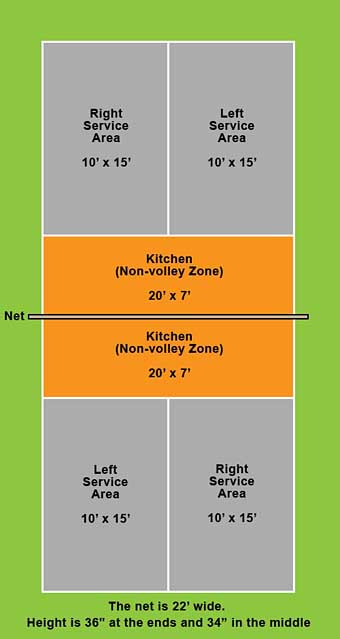Pickleball Court Dimensions

The Pickleball Court
A standard pickleball court is 20 feet wide and 44 feet long, the same dimensions used for both singles and doubles play. Central to the court is the "kitchen," or non-volley zone, which is 20 feet wide and 7 feet deep on each side of the net. Players are not allowed to step into the kitchen unless the ball first bounces there. Beyond the kitchen, each side of the court is divided into two service areas, measuring 10 feet by 15 feet each. The net height is 36 inches at the sidelines and 34 inches at the center.
Key Pickleball Court Dimensions:
- Court size: 20' x 44' (same for singles and doubles)
- Kitchen (non-volley zone): 20' x 7' on each side of the net
- Service areas: 10' x 15' each
- Net height: 36" at the ends, 34" at the center
These dimensions are consistent across indoor and outdoor courts, ensuring players experience uniform gameplay regardless of location. However, the surface type can greatly affect ball behavior and player movement, making it important to understand the differences between indoor and outdoor pickleball courts.
Indoor Pickleball Courts:
Indoor courts are commonly found in gymnasiums, recreation centers, and sports facilities. They typically feature hardwood or synthetic surfaces, each offering distinct advantages:
- Hardwood surfaces: Provide consistent and predictable ball bounce, ideal for precise shots and swift movement.
- Synthetic surfaces: Materials like vinyl or rubber offer durability, low maintenance, and mimic hardwood's playing characteristics.
Indoor courts shield players from weather conditions, allowing for consistent gameplay year-round. Non-marking court shoes are recommended to protect the surface and provide proper traction.
Outdoor Pickleball Courts:
Outdoor courts are typically located in parks, community centers, or private residences. Common surfaces include:
- Asphalt: Durable with moderate ball bounce and a slightly rough texture that can influence spin.
- Concrete: Offers faster ball speeds but lower bounce; ideal for players who prefer an aggressive style of play.
- Acrylic or rubberized coatings: Often added to enhance durability and improve ball response.
Outdoor courts provide the advantage of natural light and fresh air, though weather conditions can impact gameplay. For outdoor play, choose footwear with durable outsoles to handle rougher surfaces.
Maintaining Pickleball Courts:
Regular court maintenance ensures a safe and enjoyable playing experience. For a comprehensive list of professional pickleball court construction and maintenance services, visit The Pickleball Directory.
- Clean courts to remove debris and dirt.
- Repair cracks or uneven surfaces promptly.
- Apply appropriate surface coatings to improve durability and playability.
The choice between indoor and outdoor courts depends on personal preference, availability, and weather. Indoor courts offer controlled environments and consistent play, while outdoor courts provide a more natural setting with fresh air and sunlight. Both options cater to a variety of playing styles and preferences.
